ITECH2101 Processes and Methods Sample Assignment
ITECH2101 – Software Engineering: Processes and Methods
Author Note
Introduction
The purpose of this report is to analyze the system requirements essential for the delivery of an effective and ATM system interrelating the customers and the Bank procedures. The aim of this report is to analyze the needs and requirements of the bank, customers, and other relative stakeholders. ATM system is one of the delegating system for the bank and providing better and enhanced services to the consumers and ensuring that the system works efficiently and the user is capable of understanding the procedures and steps involved during the transaction. User interface should be kept at very less complexity level in manner to ensure that the customers and users are easily connecting to the system. This report presents the dataflow diagram at different levels ensuring the exchange of data and information while user is utilizing the banking services. An event response table has also been expressed in this report considering the triggering and ending of the project.
Cycle 1: Events and Structured Analysis with Data Flow Diagrams
A. Event Table Entries
|
Event |
Event Type |
Trigger |
Activity/Use Case |
Response |
Destination |
|
Maintenance being maintained for the proper functioning of the ATM machine |
Response |
ATM technicians uses personal credentials |
Maintenance |
Allows the technician to integrate and disintegrate the physical parts |
ATM technician |
|
Repair the bugs and glitches restricting the ATM from functioning with efficiency |
Response |
ATM technicians uses personal credentials |
Repair |
ATM technician would be able to manipulate the software system of the ATM machine |
ATM technician |
|
Wants to Swipe the cash card for making transaction with the bank |
Response, Image |
Customer swipes the cash card in the ATM vending machine |
Session |
Either allowed to make the transaction or discarded due to expiry of cash card |
User |
|
Upgrading the system with new functions |
Image, response |
ATM technician connect the system to the server |
Upgrades |
The software can be uploaded as a patch up |
New systems will be introduced to the customers |
|
Diagnosing the existing system and identifying the bugs and glitches |
Image, response |
After verifying credentials by the ATM technician |
Diagnosis |
ATM technician would be able to analyze the bugs and glitches of the system |
ATM technician |
|
Switch on and off |
Response |
After verifying credentials by the ATM technician |
Switch on and off |
Technician will managing the switching of thw ATM |
ATM tecnician |
|
Cash Card authentication |
Image, Response |
Swiping the cash card and entering authentication credentials |
Authentication |
User would be allowed to make the transaction after completing the authentication |
User and Bank |
|
Type of transaction, the user wants to make with the Bank |
Response, Image |
Authentication of the cash card completed and screen shows optional selection for the type of transaction |
Type of transaction |
The user would be able to get the necessary output |
User and Bank |
|
Pin verification by the user input for the transactions |
Response, image |
Card swiped |
Pin Verification |
The system will allow the transaction only after the pin verification |
User |
|
Depositing money to the bank |
Response, image |
Pin verified |
Deposit |
The user would be able to make the deposit and the amount will be reflected in his or her bank account |
User |
|
Inquiry about the bank details and transactions made in previous days |
Response, image |
After pin is verified |
Inquiry |
The user will be presented with the previous transactions and all other transactions made recently |
User and Bank |
|
Transferring the money to another user of same bank or other bank |
Response, image |
After pin verification is completed |
Money transfer |
The user would be able to transfer the money into other individual’s bank account |
User and Bank |
|
Printing Receipt |
Response |
After transaction is completed |
Print receipt |
The user will be terminated from the system and evidence will be provided for the transaction |
User |
B. Context Diagram
C. Level 0 Data Flow Diagram
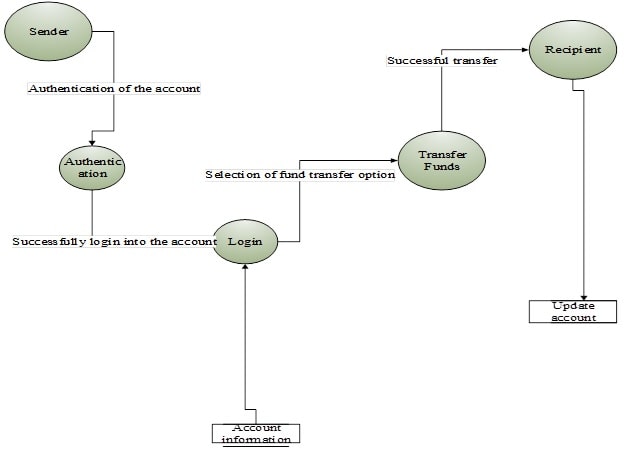
Figure 1: DFD level 0 Data Flow
(Source: Created by Author)
The above diagrams represents the exchange of data and information at level zero emphasizing the user interacting with the banking system or ATM system and making transaction with the bank. The user will have to connect with the bank server for making the transaction and that can be accomplished either through authenticating the cash card or through logging in the bank network.
D. Level 1 Data Flow Diagram
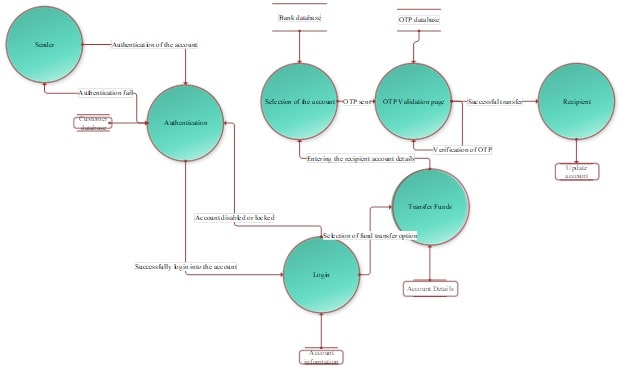
Figure 2: Data Flow Diagram level 2
(Source: Created by Author)
This is level two diagram explaining the additional data flow between the system and the user emphasizing on the delivery of the services being made available to the customers. The level zero diagram explained the simple procedure however; this diagram expresses the data exchange between the database of the ATM, Bank, and utilizing those information, the system will be generating the output.
Cycle 2: Object Oriented Analysis and Design Modelling
A. Use Case Model
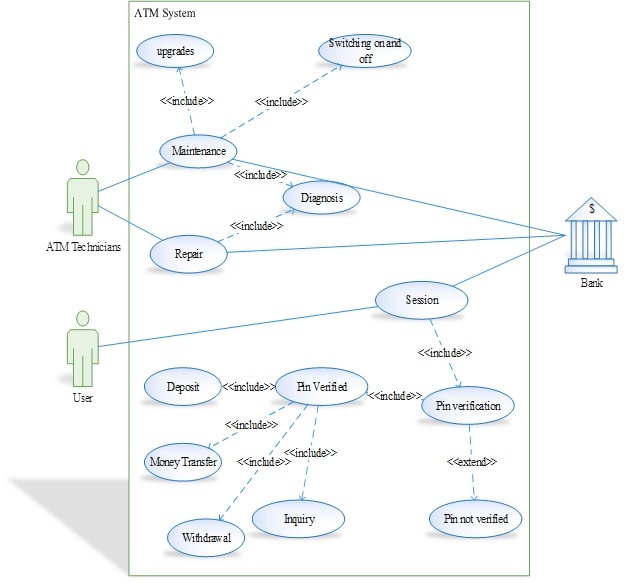
Figure 3: Use Case Diagram
(Source: Created by Author)
B. Activity Diagram
C. System Sequence Diagram
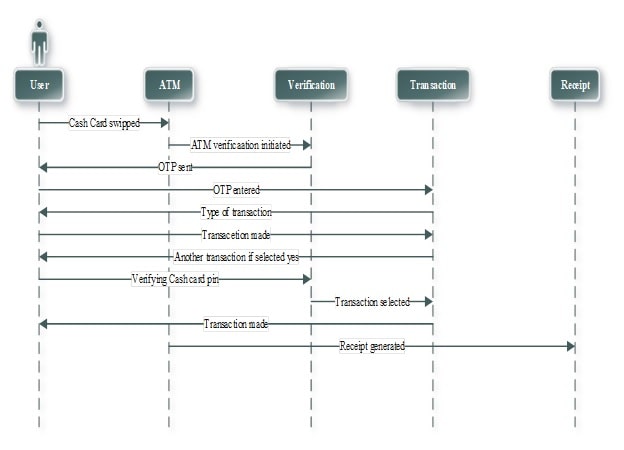
Figure 4: Sequence Diagram
(Source: Created by Author)
D. Domain Model Class Diagram
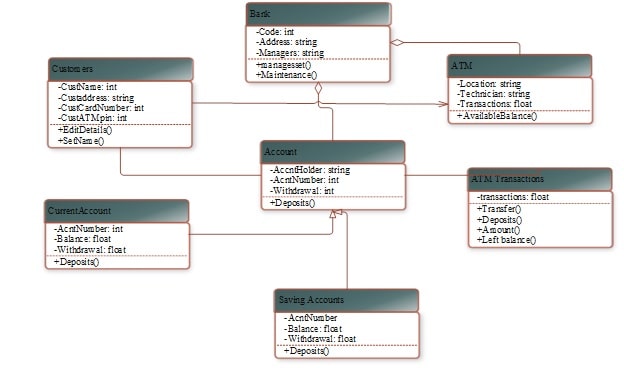
Figure 5: Domain Model Class Diagram
(Source: Created by Author)
E. Statechart Diagrams
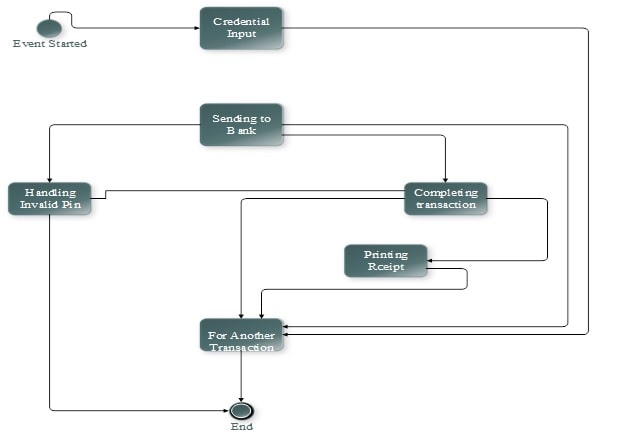
Figure 6: Start Chart Diagram
(Source: Created by Author)
Conclusion
Based on the above report it can be concluded that the ATM system has been successfully analyzed and proposed diagram effectively presents the relation and data exchange between the customers and the bank. The transaction between the ATM and the Bank has many procedures irrespective of swiping card and taking cash. The above report presented a sophisticated model for the demonstration of the ATM system on which the system will be delivering the necessary operational activities.
References
Bruesewitz, B.J., Hilgers, N., Faith, P., Siegel, K., Li, X., Koganti, K. and O'connell, C., Visa USA Inc, 2017. Method and system for providing risk information in connection with transaction processing. U.S. Patent 9,785,944.
Gonzalez, J.J. and Trcek, D., 2017, January. Proper incentives for proper IT security management–A system dynamics approach. In Proceedings of the 50th Hawaii International Conference on System Sciences.
Onyesolu, M.O. and Okpala, A.C., 2017. Improving Security Using a Three-Tier Authentication for Automated Teller Machine (ATM). International Journal of Computer Network and Information Security, 9(10), p.50.
Padalino, R., Pinnell, N., Shinn, P.C. and Yu, W., Citicorp Credit Services Inc (USA), 2018. System and method for automated debiting and settling of financial transactions. U.S. Patent 9,881,285.
Schamer, D., Lempke, L. and Kastelic, J., Huntington Bancshares Inc, 2018. System and Method for Providing Time to Cure Negative Balances in Financial Accounts While Encouraging Rapid Curing of Those Balances to a Positive Net Position. U.S. Patent Application 15/720,590.
Shafiq, M., Ahmad, M. and Choi, J.G., 2017. Public system usability analysis for the valuation of cognitive burden and interface standardization: A case study of cross-ATM design. Journal of Organizational Computing and Electronic Commerce, 27(2), pp.162-196.
Sridharan, M.K., Tamil, K.Y.K.R.S. And Kumar, K.S.A., 2017. Multi Bank ATM Family Card: Integration Of Multi Bank Multiple User In Single Card With User Behavior Monitoring Using Hmm & Formula Verification.


